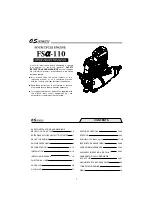
3.2
Section 3
Troubleshooting
Engine Knocks
1. Excessive engine load.
2. Low crankcase oil level.
3. Old/improper fuel.
4. Internal wear or damage.
Engine Loses Power
1. Low crankcase oil level.
2. High crankcase oil level.
3. Dirty air cleaner element.
4. Dirt or water in the fuel system.
5. Excessive engine load.
6. Engine overheating.
7. Faulty spark plug.
8. Low compression.
9. Exhaust restriction.
Engine Uses Excessive Amount Of Oil
1. Incorrect oil viscosity/type
2. Overfilled crankcase.
3. Clogged breather.
4. Worn or broken piston rings.
5. Worn cylinder bore.
6. Worn valve stems/valve guides.
Oil Leaks From Oil Seals, Gaskets
1. Crankcase breather is clogged or inoperative.
2. Loose or improperly torqued fasteners.
3. Piston blowby or leaky valves.
4. Restricted exhaust.
External Engine Inspection
Before cleaning or disassembling the engine, make a
thorough inspection of its external appearance and
condition. This inspection can give clues to what might
be found inside the engine (and the cause) when it is
disassembled.
•
Check for buildup of dirt and debris on the
crankcase, cooling fins, grass screen and other
external surfaces. Dirt or debris on these areas
are causes of overheating.
•
Check for obvious fuel and oil leaks, and
damaged components. Excessive oil leakage can
indicate a clogged or improperly assembled
breather, worn or damaged seals and gaskets, or
loose or improperly torqued fasteners.
•
Check the air cleaner cover and base for damage
or indications of improper fit or sealing.
•
Check the air cleaner element. Look for holes,
tears, cracked or damaged sealing surfaces, or
other damage that could allow unfiltered air into
the engine. Also note if the element is dirty or
clogged. These could indicate that the engine has
had inadequate or infrequent maintenance.
•
Check the carburetor throat for dirt. Dirt in the
throat is further indication that the air cleaner was
not functioning properly.
•
Check the oil level. Note if the oil level is within
the operating range on the dipstick, or if it is low
or overfilled.
•
Check the condition of the oil. Drain the oil into a
container - the oil should flow freely. Dark, dirty,
and/or thick oil could indicate infrequent
maintenance or overheating. Check for metal
chips and other foreign particles.
Sludge is a natural by-product of combustion; a
small accumulation is normal. Excessive sludge
formation could indicate the oil has not been
changed at the recommended intervals, the
incorrect type or weight of oil was used, overrich
carburetion, or weak ignition, to name a few.
NOTE: It is good practice to drain oil at a
location away from the workbench. Be
sure to allow ample time for complete
drainage.
Cleaning the Engine
After inspecting the external condition of the engine,
clean the engine thoroughly before disassembling it.
Also clean individual components as the engine is
disassembled. Only clean parts can be accurately
inspected and gauged for wear or damage. There are
many commercially available cleaners that will quickly
remove grease, oil, and grime from engine parts.
When such a cleaner is used, follow the
manufacturer’s instructions and safety precautions
carefully.
Make sure all traces of the cleaner are removed
before the engine is reassembled and placed into
operation. Even small amounts of these cleaners can
quickly break down the lubricating properties of engine
oil.
Содержание COMMAND PRO CS10
Страница 1: ...SERVICE MANUAL COMMAND PRO CS SERIES 4 12 HP HORIZONTAL CRANKSHAFT...
Страница 20: ...1 18 Section 1 Safety and General Information...
Страница 24: ...2 4 Section 2 Special Tools...
Страница 48: ...6 4 Section 6 Lubrication System...
Страница 54: ...7 6 Section 7 Retractable Starter...
Страница 84: ...8 30 Section 8 Electrical System and Components...
Страница 106: ...9 22 Section 9 Disassembly...
Страница 122: ...10 16 Section 10 Internal Components...
Страница 154: ...ENGINE DIVISION KOHLER CO KOHLER WISCONSIN 53044 LITHO IN U S A FORMNO TP 2503 A ISSUED 12 99 REVISED 8 00 MAILED 9 00...
















































